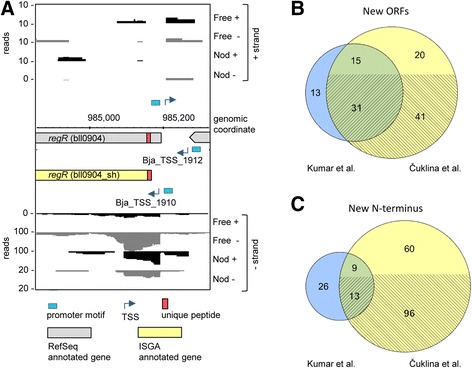Fig. 3.

Combined transcriptomics and proteomics evidence for shorter or longer protein forms and new ORFs. a Genome region of bll0904 encoding RegR (grey box, annotated by RefSeq). Predicted promoter motifs (blue box) and TSS (blue arrows) along with dRNA-seq evidence from Free and Nod indicated the existence of a shorter regR form (yellow box, ISGA annotation), whose expression is further confirmed by proteomics evidence. Unique peptides (red boxes) that provide evidence for both the long and the new, shorter protein form were observed; for clarity, the remaining peptide evidence is not shown. The TSS Bja_TSS_1912 preceding the long form of the regR gene was mapped at genomic position 985,265. The shorter form of the gene is preceded by Bja_TSS_1910 mapped at genomic position 985,187 (Additional file 3: Table S3; Additional file 7: Table S5). Note the different scales of individual libraries. For further details, see legend of Fig. 1a. b Venn diagram with the number of novel ORFs identified by a previous proteogenomics study by Kumar et al. [61], and our proteogenomics approach that is additionally guided by TSS evidence (see Methods). c Venn diagram with the number of new N-termini identified by Kumar et al. [61], who had searched for evidence for longer proteins, and our study, that also identified shorter protein forms. For b and c, the number of ORFs supported by a TSS is represented by the cross-hatched lower parts of the circles
